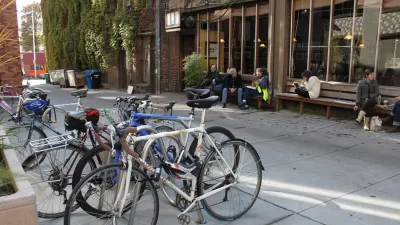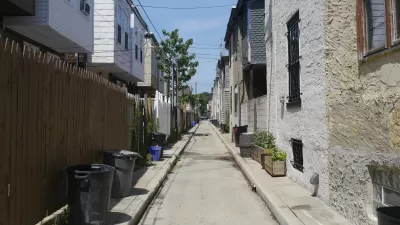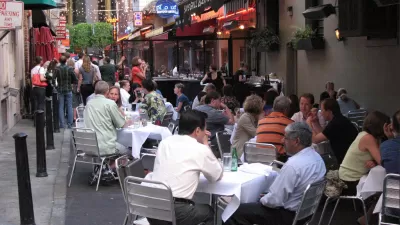From D.C. to Seattle, alleys are being reinvented as people-friendly spaces. Often perceived as dirty and dangerous, alleys are moving beyond garbage and garages to become havens for pedestrians, public art, and small business.

This might just be the most desolate alley in Denver.
Under the Evans Avenue Bridge and a stone's throw from the railroad tracks, this is an absolutely forgotten urban place, complete with the requisite tires, mattresses and beer bottles amidst the waist-high tumbleweeds.
Most of Denver's 4,000 alleys have been paved, and there are plans to pave the remaining 150 unimproved alleys by 2016. But the alleys are home to tens of thousands of dumpsters, which in turn attract illegal dumping, which in turn means plenty of scavenging.
But change is afoot. Last fall, the Rialto Cafe organized Brewer's Alley, a beer-tasting event, in the alley behind the restaurant. Several plans are in the works to activate downtown alleys off of the pedestrian 16th Street Mall.
Of course, alleys haven't always been unkempt urban voids. Alleys are as old as cities themselves, and they started off as public spaces. Dating to the early 1700s, Elfreth's Alley in Philadelphia is the oldest residential street in the country.
The word alley is more than 600 years old, owing its origin to the French alee, meaning 'walking or passage,' and aler, or 'go.’ Walking and going are rarely what modern alleys are all about -- but they inherently remain passages.
While U.S. cities have largely eschewed alley uses that don't involve garbage or garages, pre-automobile cities all over the world have historic alleys that were meant for people, complete with housing, stores, restaurants, bars and parks.
It follows that many cities are trying to activate -- or re-activate -- their alleys and make them human-scale places, sometimes with restaurants, retail and outdoor art. Cities from Los Angeles to Washington, D.C., are activating alleys for temporary special events as well as making aesthetic and functional improvements for the long haul.
FULL STORY: Alleyways become pathways to urban revitalization

Alabama: Trump Terminates Settlements for Black Communities Harmed By Raw Sewage
Trump deemed the landmark civil rights agreement “illegal DEI and environmental justice policy.”

Study: Maui’s Plan to Convert Vacation Rentals to Long-Term Housing Could Cause Nearly $1 Billion Economic Loss
The plan would reduce visitor accommodation by 25% resulting in 1,900 jobs lost.

Planetizen Federal Action Tracker
A weekly monitor of how Trump’s orders and actions are impacting planners and planning in America.

Wind Energy on the Rise Despite Federal Policy Reversal
The Trump administration is revoking federal support for renewable energy, but demand for new projects continues unabated.

Passengers Flock to Caltrain After Electrification
The new electric trains are running faster and more reliably, leading to strong ridership growth on the Bay Area rail system.

Texas Churches Rally Behind ‘Yes in God’s Back Yard’ Legislation
Religious leaders want the state to reduce zoning regulations to streamline leasing church-owned land to housing developers.
Urban Design for Planners 1: Software Tools
This six-course series explores essential urban design concepts using open source software and equips planners with the tools they need to participate fully in the urban design process.
Planning for Universal Design
Learn the tools for implementing Universal Design in planning regulations.
Caltrans
Smith Gee Studio
Institute for Housing and Urban Development Studies (IHS)
City of Grandview
Harvard GSD Executive Education
Toledo-Lucas County Plan Commissions
Salt Lake City
NYU Wagner Graduate School of Public Service




























